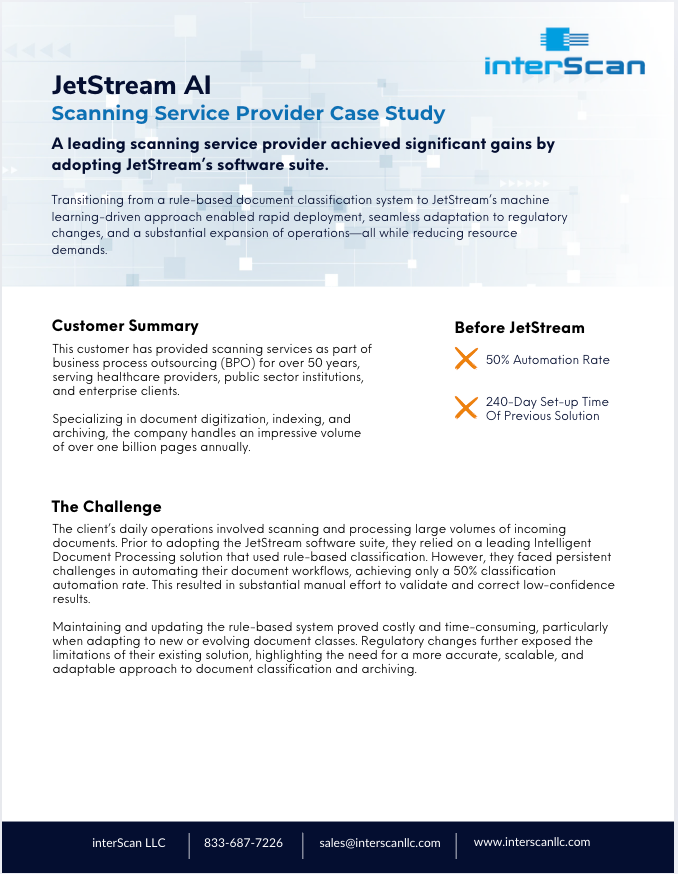Scanning Service Bureau
Learn more about how JetStream can work in real situation with this scanning service bureau case study. In which the client, the client's challenge and the potential solution in our JetStream software becomes clear
The Client: High-Volume Scanning Services Provider
This longstanding and respected client has been a trusted provider of business process outsourcing (BPO) services for over 50 years. Renowned for their deep industry expertise, they serve a diverse range of clients across the healthcare sector, government agencies, and large enterprises.
As a leader in digital transformation, they specialize in high-volume document digitization, indexing, and secure archiving. Operating at remarkable scale, the organization processes over one billion pages annually, demonstrating their capacity, efficiency, and commitment to delivering streamlined document workflows.
240-Day
Set-up Time of Previous Solution
50%
Current Position Automation Rate
The Challenge: Low & Inefficient Automation
Before adopting JetStream AI, the client managed daily volumes of inbound documents by scanning and manually reviewing entire boxes of paperwork. Their existing solution, a widely used Intelligent Document Processing (IDP) tool, relied on rule-based classification, which proved difficult to scale and maintain. Despite automation efforts, their document classification accuracy plateaued at just 50%, requiring extensive manual validation to correct misclassified or low-confidence documents.
This rule-based approach was not only labor-intensive, but also costly to update. Adding new document classes or adapting existing ones, demanded significant time and technical effort, especially in response to regulatory changes. As regulations evolved and more restrictive, their legacy system struggled to deliver the accuracy and flexibility needed for compliant document handling.
This customer struggled with low automation rates, rising operational costs, and limited adaptability, and recognized the need for a more intelligent, scalable, and maintenance-light solution which lead them to evaluate and ultimately implement JetStream AI.
The Solution: JetStream to Increase Efficiency and Automation
Automation for Document Classification
During the evaluation phase, the implementation of JetStream demonstrated exceptional performance. Right out of the box, it achieved an impressive automation rate of 90% for document classification. This accomplishment can be credited to JetStream's cutting-edge OCR engine, which provides remarkable accuracy and confidence scores.
Machine Learning & Quick Setup
JetStream's rule-free, few-shot learning approach, sets it apart from the previous solution. This enabled a swift initial setup, taking less than 3-days, a significant improvement compared to the lengthy 240-day setup time required by the previous solution. The client faced regulatory changes that necessitated a substantial increase in document classes, going from approximately 150 to over 300. JetStream's ability to quickly adapt to these new document classes allowed the client to quickly meet their requirements.
Reduction in Manual Effort & Minimizing False Positives
The implementation of JetStream had a substantial impact, resulting in an 80% reduction in manual efforts. This was achieved through increased straight-through processing, even with the client's objective of minimizing false positive results to less than 1%. The significant improvement in automation provided by JetStream empowers our client to scale their business significantly.
The Benefits & Results of JetStream Implementation

Outlook: Growth Through JetStream Automation
Processing large batches of documents, especially PDFs containing 100 or more consecutive forms, can be extremely challenging. Automating the classification of these documents based on their categories may seem nearly impossible. Currently, the process of separating these documents requires a significant amount of manual effort, involving the insertion of separator sheets between each document.
However, looking to the future, the client plans to tackle this issue by utilizing JetStream's document splitting feature. This feature will allow them to train a neural network to automatically identify the start and end of multi-page documents or split documents based on a fixed number of pages using rule-based methods.
By taking advantage of JetStream's data extraction capabilities, the client will have the opportunity to expand their service portfolio and explore further growth opportunities.


